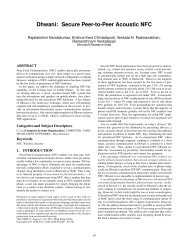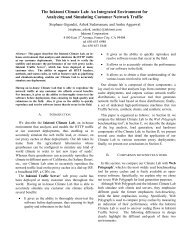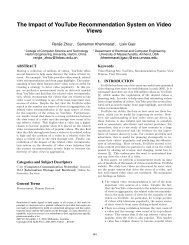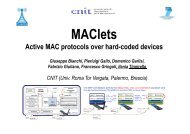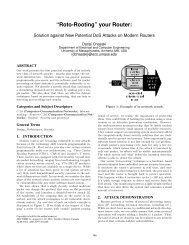Network Traffic Characteristics of Data Centers in the Wild - Sigcomm
Network Traffic Characteristics of Data Centers in the Wild - Sigcomm
Network Traffic Characteristics of Data Centers in the Wild - Sigcomm
Create successful ePaper yourself
Turn your PDF publications into a flip-book with our unique Google optimized e-Paper software.
CDF<br />
CDF<br />
CDF<br />
(a)<br />
(b)<br />
(c)<br />
1<br />
0.8<br />
0.6<br />
0.4<br />
0.2<br />
0<br />
0.01 0.1 1 10 100<br />
1<br />
0.8<br />
0.6<br />
0.4<br />
0.2<br />
Max-Trough for Edge L<strong>in</strong>k<br />
EDU1<br />
EDU3<br />
PRV1<br />
PRV2<br />
CLD1<br />
CLD2<br />
CLD3<br />
CLD4<br />
CLD5<br />
0<br />
0.01 0.1 1 10 100<br />
1<br />
0.8<br />
0.6<br />
0.4<br />
0.2<br />
Max-Trough for Agg L<strong>in</strong>k<br />
PRV2<br />
CLD1<br />
CLD2<br />
CLD3<br />
CLD4<br />
CLD5<br />
0<br />
0.01 0.1 1 10 100<br />
Max-Trough for Core L<strong>in</strong>k<br />
EDU1<br />
EDU3<br />
PRV1<br />
PRV2<br />
CLD1<br />
CLD2<br />
CLD3<br />
CLD4<br />
CLD5<br />
Figure15:Differencebetween<strong>the</strong>peakandtroughutilization.<br />
7. IMPLICATIONSFORDATACENTER<br />
DESIGN<br />
7.1 Role<strong>of</strong>BisectionBandwidth<br />
Severalproposals[1,22,11,2]fornewdatacenternetworkarchitecturesattempttomaximize<strong>the</strong>networkbisectionbandwidth.<br />
Theseapproaches,whilewellsuitedfordatacenters,whichrun<br />
applicationsthatstress<strong>the</strong>network’sfabricwithall-to-alltraffic,<br />
wouldbeunwarranted<strong>in</strong>datacenterswhere<strong>the</strong>bisectionbandwidthisnottaxedby<strong>the</strong>applications.Inthissection,were-evaluate<br />
<strong>the</strong>SNMPandtopologydatacapturedfrom<strong>the</strong>10datacentersand<br />
exam<strong>in</strong>ewhe<strong>the</strong>r<strong>the</strong>prevalenttrafficpatternsarelikelytostress<strong>the</strong><br />
exist<strong>in</strong>gbisectionbandwidth. Wealsoexam<strong>in</strong>ehowmuch<strong>of</strong><strong>the</strong><br />
exist<strong>in</strong>gbisectionbandwidthisneededatanygiventimetosupport<br />
<strong>the</strong>prevalenttrafficpatterns.<br />
Beforeexpla<strong>in</strong><strong>in</strong>ghowweaddress<strong>the</strong>sequestions,weprovide<br />
afewdef<strong>in</strong>itions. Wedef<strong>in</strong>e<strong>the</strong>bisectionl<strong>in</strong>ksforatiereddata<br />
centertobe<strong>the</strong>set<strong>of</strong>l<strong>in</strong>ksat<strong>the</strong>top-mosttier<strong>of</strong><strong>the</strong>datacenter’s<br />
treearchitecture;<strong>in</strong>o<strong>the</strong>rwords,<strong>the</strong>corel<strong>in</strong>ksmakeup<strong>the</strong>bisectionl<strong>in</strong>ks.Thebisectioncapacityis<strong>the</strong>aggregatecapacity<strong>of</strong><strong>the</strong>sel<strong>in</strong>ks.Thefullbisectioncapacityis<strong>the</strong>capacitythatwouldberequiredtosupportserverscommunicat<strong>in</strong>gatfulll<strong>in</strong>kspeedswith<br />
arbitrarytrafficmatricesandnooversubscription. Thefullbisec-<br />
278<br />
Precent <strong>of</strong> Bisection Utilized<br />
0 10 20 30<br />
CLD1<br />
CLD2<br />
CLD3<br />
CLD4<br />
CLD5<br />
EDU1<br />
<strong>Data</strong> Center<br />
EDU2<br />
EDU3<br />
Current<br />
Full<br />
Figure16:Thefirstbaris<strong>the</strong>ratio<strong>of</strong>aggregateservertraffic<br />
overBisectionBWand<strong>the</strong>secondbaris<strong>the</strong>ratio<strong>of</strong>aggregate<br />
servertrafficoverfullbisectioncapacity. They-axisdisplays<br />
utilizationasapercentage.<br />
tioncapacitycanbecomputedassimply<strong>the</strong>aggregatecapacity<strong>of</strong><br />
<strong>the</strong>serverNICs.<br />
Return<strong>in</strong>gto<strong>the</strong>questionsposedearlier<strong>in</strong>thissection,weuse<br />
SNMPdatatocompute<strong>the</strong>follow<strong>in</strong>g:(1)<strong>the</strong>ratio<strong>of</strong><strong>the</strong>current<br />
aggregateserver-generatedtrafficto<strong>the</strong>currentbisectioncapacity<br />
and(2)<strong>the</strong>ratio<strong>of</strong><strong>the</strong>currenttrafficto<strong>the</strong>fullbisectioncapacity.<br />
Indo<strong>in</strong>gso,wemake<strong>the</strong>assumptionthat<strong>the</strong>bisectionl<strong>in</strong>kscan<br />
betreatedasas<strong>in</strong>glepool<strong>of</strong>capacityfromwhichall<strong>of</strong>feredtraffic<br />
candraw. Whilethismaynotbetrue<strong>in</strong>allcurrentnetworks,it<br />
allowsustodeterm<strong>in</strong>ewhe<strong>the</strong>rmorecapacityisneededorra<strong>the</strong>r<br />
betteruse<strong>of</strong>exist<strong>in</strong>gcapacityisneeded(forexample,byimprov<strong>in</strong>g<br />
rout<strong>in</strong>g,topology,or<strong>the</strong>migration<strong>of</strong>applicationservers<strong>in</strong>side<strong>the</strong><br />
datacenter).<br />
InFigure16,wepresent<strong>the</strong>setworatiosforeach<strong>of</strong><strong>the</strong>data<br />
centersstudied.Recall(fromTable2)thatalldatacentersareoversubscribed,mean<strong>in</strong>gthatifallserverssentdataasfastas<strong>the</strong>ycan<br />
andalltrafficleft<strong>the</strong>racks,<strong>the</strong>n<strong>the</strong>bisectionl<strong>in</strong>kswouldbefully<br />
congested(wewouldexpectt<strong>of</strong><strong>in</strong>dutilizationratiosover100%).<br />
However,wef<strong>in</strong>d<strong>in</strong>Figure16that<strong>the</strong>prevalenttrafficpatternsare<br />
suchthat,even<strong>in</strong><strong>the</strong>worstcasewhereallserver-generatedtraffic<br />
isassumedtoleave<strong>the</strong>rackhost<strong>in</strong>g<strong>the</strong>server,<strong>the</strong>aggregateoutput<br />
fromserversissmallerthan<strong>the</strong>network’scurrentbisectioncapacity.<br />
Thismeansevenif<strong>the</strong>applicationsweremovedaroundand<br />
<strong>the</strong>trafficmatrixchanged,<strong>the</strong>currentbisectionwouldstillbemore<br />
thansufficientandnomorethan25%<strong>of</strong>itwouldbeutilizedacross<br />
alldatacenters,<strong>in</strong>clud<strong>in</strong>g<strong>the</strong>MapReducedatacenters.F<strong>in</strong>ally,we<br />
notethat<strong>the</strong>aggregateoutputfromserversisanegligiblefraction<br />
<strong>of</strong><strong>the</strong>idealbisectioncapacity<strong>in</strong>allcases.Thisimpliesthatshould<br />
<strong>the</strong>sedatacentersbeequippedwithanetworkthatprovidesfullbisectionbandwidth,atleast95%<strong>of</strong>thiscapacitywouldgounused<br />
andbewastedbytoday’strafficpatterns.<br />
Thus,<strong>the</strong>prevalenttrafficpatterns<strong>in</strong><strong>the</strong>datacenterscanbesupportedby<strong>the</strong>exist<strong>in</strong>gbisectioncapacity,evenifapplicationswere<br />
placed<strong>in</strong>suchawaythat<strong>the</strong>rewasmore<strong>in</strong>ter-racktrafficthan<br />
existstoday.Thisanalysisassumesthat<strong>the</strong>aggregatecapacity<strong>of</strong><br />
<strong>the</strong>bisectionl<strong>in</strong>ksformsasharedresourcepoolfromwhichall<br />
<strong>of</strong>feredtrafficcandraw.If<strong>the</strong>topologypreventssome<strong>of</strong>feredtrafficfromreach<strong>in</strong>gsomel<strong>in</strong>ks,<strong>the</strong>nsomel<strong>in</strong>kscanexperiencehigh<br />
utilizationwhileo<strong>the</strong>rsseelowutilization.Even<strong>in</strong>thissituation,<br />
however,<strong>the</strong>issueisone<strong>of</strong>chang<strong>in</strong>g<strong>the</strong>topologyandselect<strong>in</strong>g<br />
arout<strong>in</strong>galgorithmthatallows<strong>of</strong>feredtraffictodraweffectively<br />
PRV1<br />
PRV2



